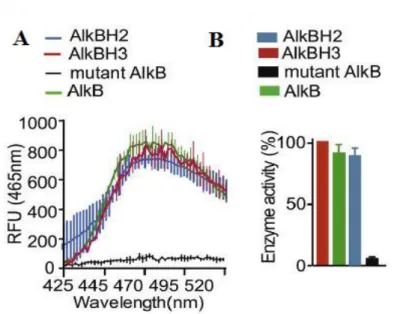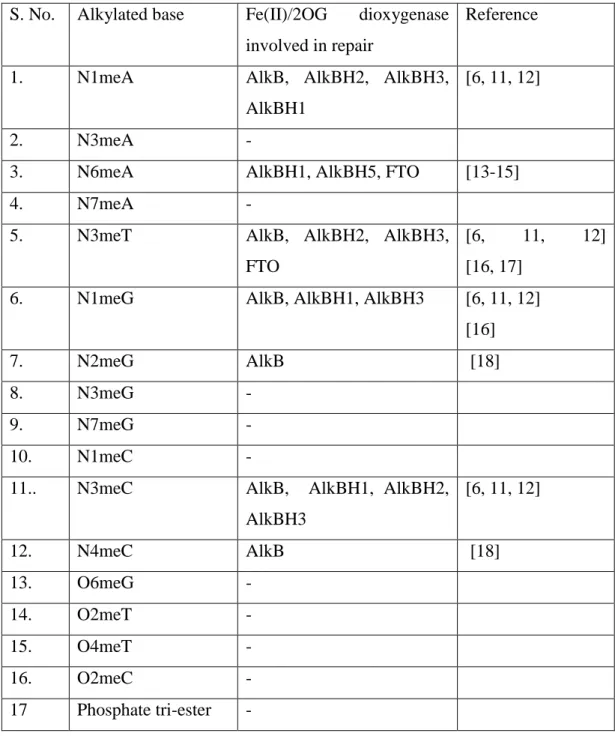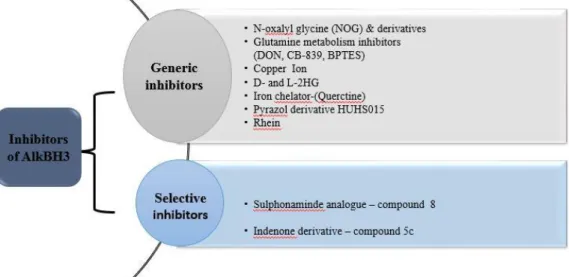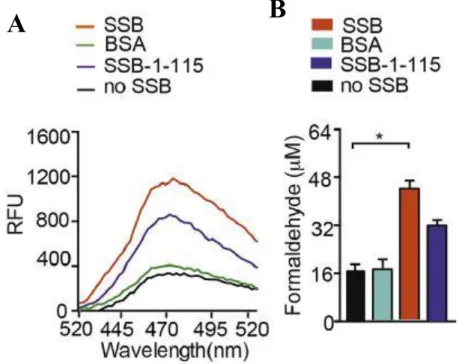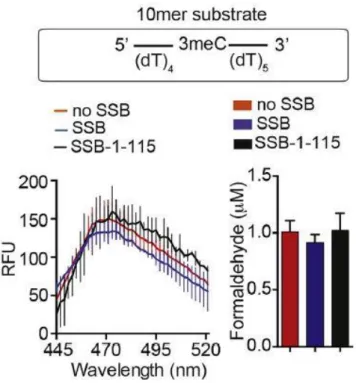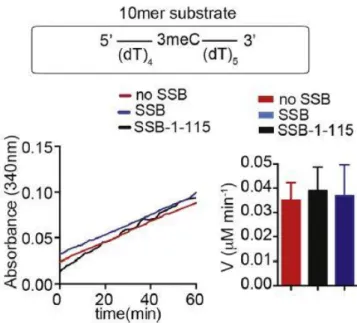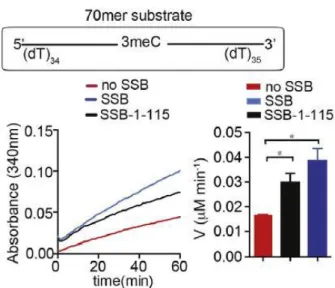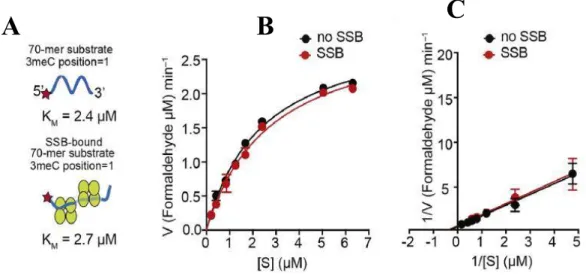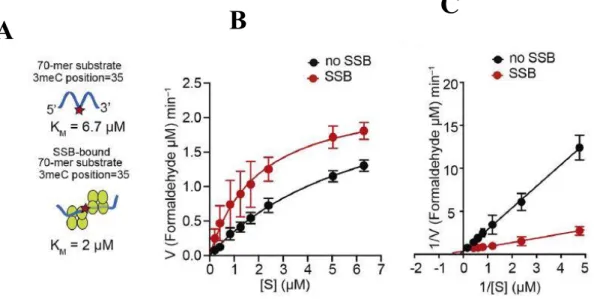It was found that the truncated SSB can also facilitate the repair activity of AlkB. It was observed that the interaction of AlkB and SSB was lost at high NaCl concentrations.

Introduction
Alkylation damage to DNA
DNA damaging agents
Johannessen, T.-C.A., et al., The DNA repair protein ALKBH2 mediates temozolomide resistance in human glioblastoma cells. Liefke, R., et al., The oxidative demethylase ALKBH3 marks hyperactive gene promoters in human cancer cells.
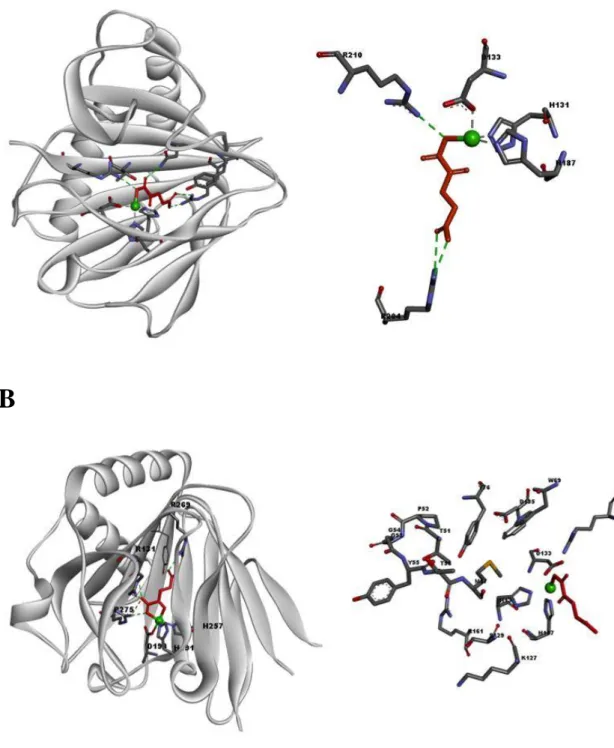
Cellular defence against alkylation damage
Molecular mechanism of DNA dealkylation repair
W76 forms hydrogen bond interactions with the two phosphates of the 5' methylated base, holding the substrate in the active site. AlkB changes the DNA framework around the alkylated base so that the alkylated base faces out into the active site and the two flanking bases are "squeezed" and folded together.
Human homologs of AlkB
AlkBH4 was recently identified as Fe(II)-2OG dependent dioxygenase based on structural conservation but the substrate specificity and biological functions remain largely unknown [78]. AlkBH6 was found to be localized in the nucleus as well as cytoplasm in normal human tissues [84].
AlkBH3 and cancer
Like prostate cancer, high AlkBH3 level in pancreatic cancer is associated with poor prognosis. RNAi-mediated knockdown of AlkBH3 in KU7 cells leads to cell cycle arrest in the G1 phase.
Inhibition of AlkBH3
However, one of the factors hindering the design of an AlkBH3 inhibitor is the fact that the crystal structure of. They also proposed that the binding site of the ligand is the DNA binding site of AlkBH3.
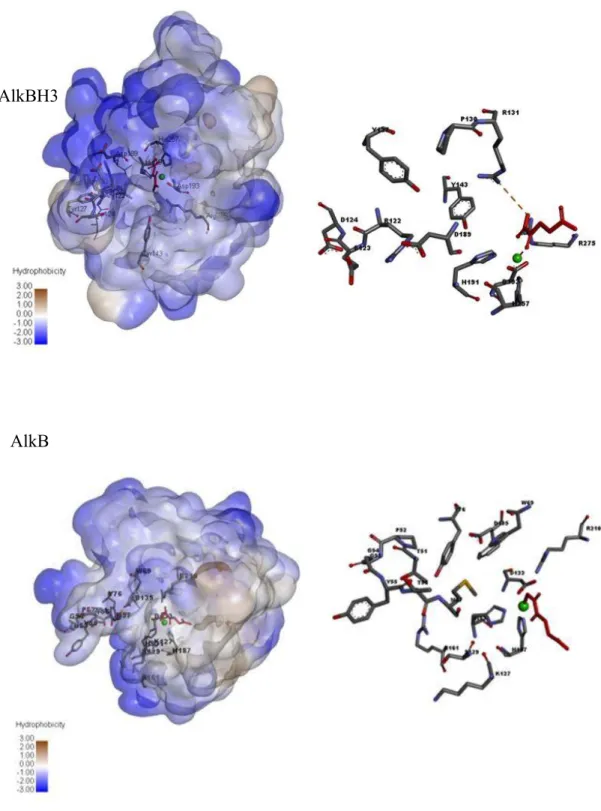
Indenone derivatives as AlkBH3 inhibitor
Indenone analogs have been used as a novel scaffold to target androgen receptors in breast cancer[142]. Indenone derivatives have also been used as fermentation activators, estrogen binding receptors and precursors for gibberellins[147].
Significance and specific objectives
- Specific objectives
It can be speculated that inhibition of the AlkBH3 repair pathway will lead to the accumulation of DNA damage. Inhibition of AlkBH3 can cause extensive DNA damage in cells endogenously, ultimately causing prolonged cell cycle arrest.
Lee, D.-H., et al., Repair of methylation damage in DNA and RNA by mammalian AlkB homologues.
Functional characterization of E. coli DNA repair protein AlkB
Introduction
During recombination, SSB helps in heteroduplex formation by binding to the displaced strand and preventing strand annealing [11]. SSB is also involved in DNA repair pathways, including base excision repair and recombination repair [12–14].
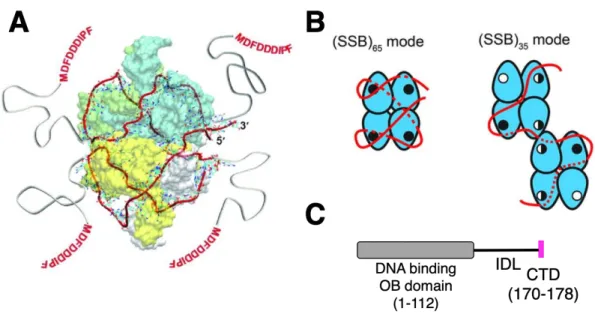
Materials and method
- cloning
- Purification of recombinant proteins
- N3meC containing oligonucleotide substrate
- Preparation of methylated DNA substrate
- Preparation of Acetoacetanillide
- Preparation of Ammonium acetate
- Demethylation assay by direct detection of formaldehyde
- Preparation of formaldehyde standard curve
- Demethylation assay by FDH coupled indirect detection of formaldehdye
- Enzyme kinetic analysis
The culture was then induced with 1 mM IPTG and maintained for 5 h at 30ºC at 200 rpm. The sample was then centrifuged at 14,000 rpm for 20 minutes at 4ºC to remove insoluble debris. The 70-mer oligonucleotide substrate consisting of 69 thymines and single N3meC at the 35th, 15th, or first position was chemically synthesized (Active™- Imperial Life Sciences).
The buffer was prepared in a 50 ml tube which was kept on ice throughout. 40 μl of ammonium acetate and 10 μl of acetoacetanilide were added to the reaction mixture containing the desired concentration of formaldehyde in the demethylation assay buffer. The 15th position or 70 mer oligonucleotide with terminally located methylating nucleotide was used as substrate for enzyme kinetic analysis.
AlkB (0.2 µM) was mixed with the eight different concentrations of SSB-bound or free 70-mer internal N3meC-containing oligonucleotide (ranging from 0.2 to 6.3 µM).
Results and discussion
- SSB facilitated repair of longer ssDNA by AlkB
- FDH coupled indirect assay to confirm SSB promotes AlkB activity
- AlkB enzyme kinetics in presence of SSB
To study that AlkB-mediated repair activity was investigated in the presence of SSB-bound ssDNA containing methylated nucleotide as substrate. 70-mer oligonucleotide with single N3meC at position 35 (2 µM) was used as substrate for AlkB (0.2 µM) in the presence or absence of SSB (4 µM). Truncated SSB lacking the C-terminal unstructured region (SSB-1-115) also resulted in stimulation of AlkB-mediated repair of the 70-mer N3meC containing oligonucleotide (Fig. 8).
Next, the repair reaction with 70-mer oligonucleotide (2 µM) with single N3meC at position 35 was studied. First, 70-mer oligo-dT with single N3meC at the 5′ end was examined for repair in presence or absence of AlkB ( Fig. 11 ). It was observed that AlkB was able to repair 70-mer terminal N3meC-containing oligonucleotide with a KM value 2.4 µM.
These results revealed an important role of SSB in AlkB-mediated repair of large ssDNA.
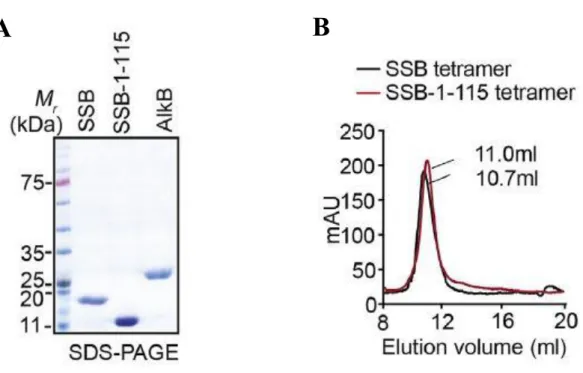
Varshney, Chimeras between single-stranded DNA binding proteins from Escherichia coli and Mycobacterium tuberculosis reveal that their C-terminal domains interact with uracil DNA glycosylases. Interactions involving RecO and RecR overcome inhibition of RecA by a single-stranded DNA-binding protein. Bhagwat, Kinetic studies of Escherichia coli AlkB using a novel fluorescent DNA demethylation assay.
Delaney, J.C., et al., AlkB reverses ethno-DNA lesions caused by lipid oxidation in vitro and in vivo. Hollis, Structural and mutational analysis of Escherichia coli AlkB provides insights into substrate specificity and DNA damage detection. Yu, B., et al., Crystal structures of catalytic complexes of the oxidative DNA/RNA repair enzyme AlkB.
Varshney, Cloning, over-expression and biochemical characterization of the single-stranded DNA-binding protein from Mycobacterium tuberculosis.
Interaction of AlkB with SSB
Introduction
In this chapter, the analysis of the SSB-AlkB interaction was performed to determine whether SSB can bind to AlkB. For this purpose, several truncated SSB constructs were generated and the SSB-AlkB interaction was studied by yeast two-hybrid and pull-down analysis. Surprisingly, it was found that this binding of SSB to AlkB involves the IDL of SSB.
The C-terminal acidic domain of SSB, which is widely involved in protein-protein interaction, is indispensable for this interaction.
Materials and method
- cloning
- In vitro GST pull down assay
- Purification of recombinant His-AlkB protein
- Preparation of glutathion sepharose bead-bound GST-SSB
- Interaction of glutathion bead-bound GST-SSB and His-AlkB
- SDS-PAGE
- Western blotting
- Isothermal titration calorimetry(ITC)
- Purification of tagless AlkB
- The Peptide ligand for ITC
- ITC experiment
- CD-spectroscopy
- Preparation of protein
- CD-experiment
- Yeast two-hybrid analysis of SSB-AlkB interaction
- Yeast strain
- Media preparation
- Yeast transformation
- Yeast two-hybrid analysis
- HIS3 selection for interaction positive cells
- Colony lift filter assay using lacZ reporter
Costes, A., et al., The C-terminal domain of the bacterial SSB protein functions as a DNA maintenance hub at active chromosome replication forks. Marceau, AH, et al., Structure of the SSB-DNA polymerase III interface and its role in DNA replication. 1 µM of the substrate (single-stranded 40-mer oligonucleotide DNA containing single N3-meC) was then added to the AlkB reaction mixture and incubated for 1 hour.
It was found that the Vmax remained unchanged in the presence of 3o implying a competitive mode of inhibition (Fig. 25A). The initial velocities of AlkB were also analyzed by varying concentration of the co-substrate 2OG while maintaining a fixed saturating concentration of DNA. substrate. Fedeles, B.I., et al., The AlkB family of Fe (II)/α-ketoglutarate dependent dioxygenases: repair of nucleic acid alkylation damage and beyond. Kurowski, M.A., et al., Phylogenomic identification of five novel human homologues of the DNA repair enzyme AlkB.
Mabuchi, M., et al., Improving the bioavailability and anticancer effect of the PCA-1/ALKBH3 inhibitor HUHS015 using sodium salt.
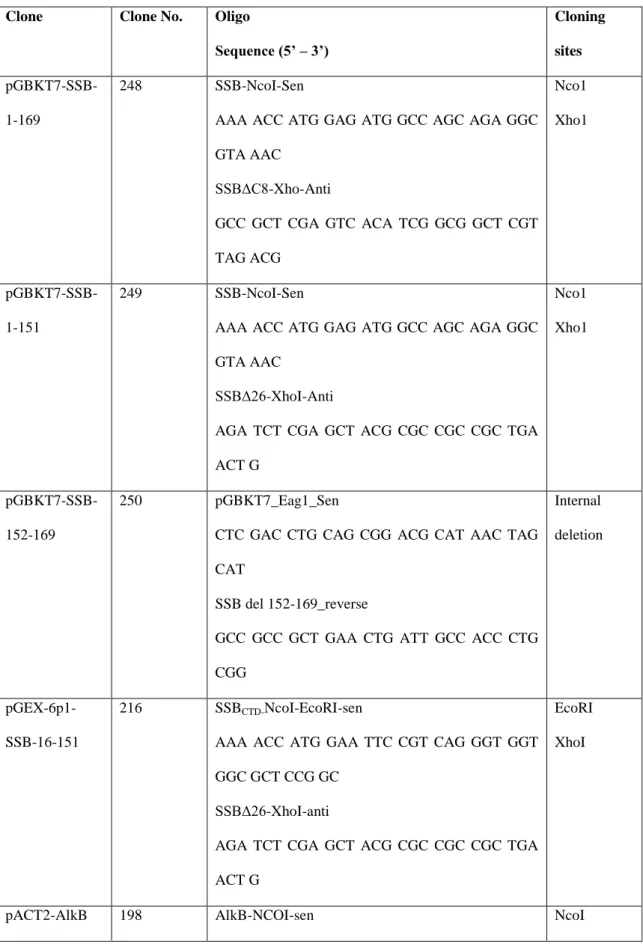
Results and discussion
- Characterization of direct interaction of AlkB with SSB by yeast-two-hybrid assay 92
- Examination of the strength of SSB-AlkB interaction
Furukohri, A., et al., Interaction between Escherichia coli DNA polymerase IV and single-stranded DNA-binding protein is required for DNA synthesis on SSB-coated DNA. Arad, G., et al., A single-stranded DNA-binding protein recruits DNA polymerase V to primers on RecA-coated DNA.
Screening and evaluation of indenone derivatives as AlkB
Introduction
Materials and method
- cloning
- Purification of recombinant AlkB
- Preparation of methylated DNA substrate
- Screening of Indenone analogs for AlkB inhibition
- Determination of IC50
- CD-spectroscopy
- Isothermal titration calorimetry (ITC)
- Enzyme kinetics
- Molecular docking
- Cell survival assay
- Effect of compound 3o on MMS sensitivity
The ability of compound 3o to form a complex with AlkB was evaluated using isothermal titration calorimetry (ITC). Also, the intersection of the lines corresponding to different concentrations of 3o was above the y-axis in the Lineweaver-Burk plot (Fig. 25B). This study revealed the ability of one of the compounds 3o to be competitive inhibitors of AlkB-catalyzed DNA demethylation.
To determine the selectivity of the compounds, we tested the effect of 5c on the activity of E. Steady-state enzyme kinetics were performed to study the inhibition mechanism of the compounds. Taken together, molecular docking analysis revealed a structure-activity relationship of AlkBH3 inhibition by 5c and suggested that the binding of 5c in the immediate vicinity of the active site could influence the catalytic activity of AlkBH3.
The primary screens, based on in vitro inhibition of AlkBH3 demethylase activity using single base methylated DNA substrate and purified enzyme, resulted in one inhibitor against human AlkBH3.
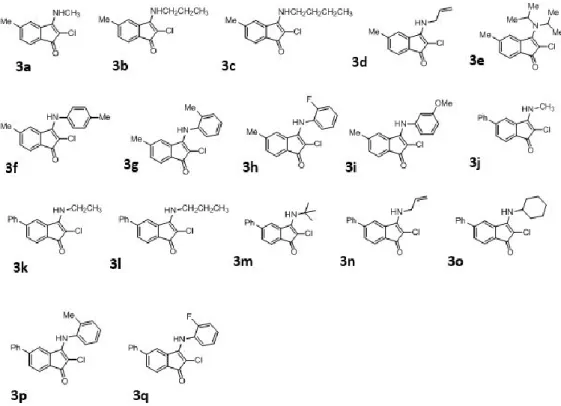
Results and discussion
- Evaluation of Indenone compounds as inhibitor of DNA demethylation repair protein
- Conformational and binding analysis of AlkB and 3o
- Mechanism of inhibition of AlkB
- Prediction of binding pocket
- Inhibition of AlkB by 3o significantly enhances cell death
Nakao, S., et al., Design and synthesis of prostate cancer antigen-1 (PCA-1/ALKBH3) inhibitors as anti-prostate cancer drugs. Li, Q., et al., Rhein inhibits AlkB repair enzymes and sensitizes cells to methylated DNA damage. Hunt, Enzymological and structural studies of the mechanism of promiscuous substrate recognition by the oxidative DNA repair enzyme AlkB.
Screening and evaluation of indenone derivatives as potential
Introduction
In addition, a high level of AlkBH3 expression is also found in non-small cell lung cancer [15], pancreatic cancer [22]. Since overexpression of AlkBH3 is strongly associated with cancer, selective inhibitors for AlkBH3 are highly desirable. The aim of this chapter was to test indenone derivatives for potential inhibition of AlkBH3.
Materials and method
- cloning
- Purification of proteins
- Preparation of methylated DNA substrate
- Preparation of double straded DNA substrate
- In vitro screening
- Determination of IC50
- CD-spectroscopy
- Isothermal titration calorimetry (ITC)
- Enzyme kinetics
- Molecular docking
- Cytotoxicity analysis
- Effect of AlkBH3 inhibition on cell proliferation
- MMS sensitivity of A549 cells
Desalted oligonucleotide 40mer polydT with single C (5' TTT TTT TTT TTT TTT TTT C TTT TTT TTT TTT TTT TTT TTT 3') was purchased from Imperial Lifescience. A library of indenone derivatives consisting of 27 compounds was screened for inhibition of AlkBH3 demethylation activity. 1 µM of the substrate damaged by MMS was then added to a 40-mer oligonucleotide containing single N3meC to initiate the AlkB-catalyzed demethylation reaction.
The reaction was initiated by adding 5µl of the 10µM substrate, followed by further incubation of 1 hour at 37ºC. 12µM AlkBH3 and 12µM of compound 5c were mixed in assay buffer containing 10mM Tris-HCl, pH. Analysis of the docked structures and evaluation of binding energy was done using the analysis tool of Autodock suite.
The cells were also treated with 1 µM compound 5a, 5b or 5c to determine the effect of AlkBH3 inhibition on MMS sensitivity of A549 cells.
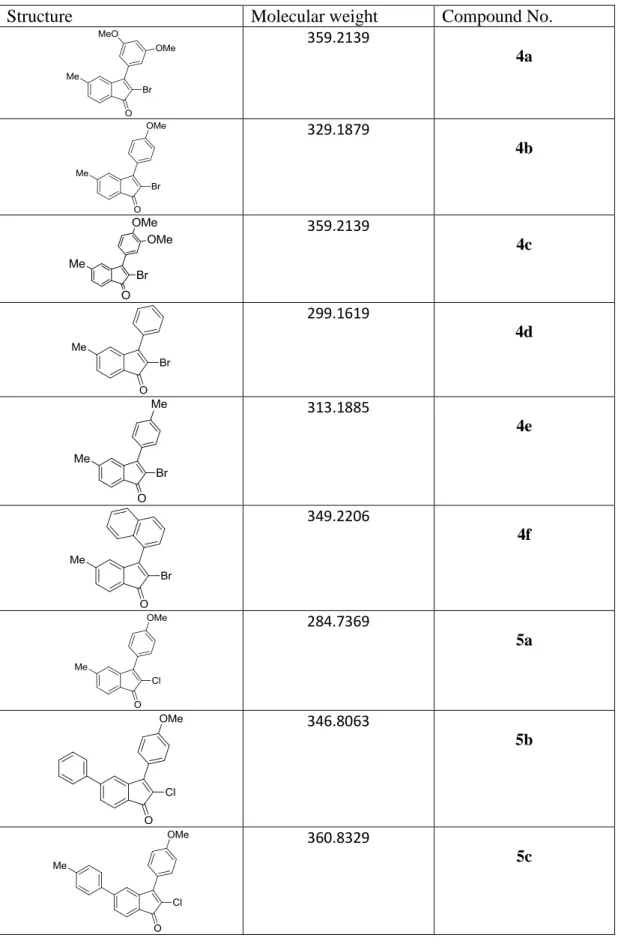
Results and discussion
- Evaluation of Indenone compounds as inhibitor of DNA repair by human
Further UV CD spectra of AlkBH3 and AlkBH3 bound to 5c revealed that the binding of 5c caused a change in the CD signal at 195 nm, characteristic of the double-stranded β-helix conformation of AlkBH3 (Figure 33). Taken together, the CD spectroscopy data strongly suggested subtle structural changes of the AlkBH3 molecule upon binding of 5c. Next, the binding of AlkBH3 to 5c was validated by quantifying the relevant thermodynamic parameters by ITC.
For this purpose, the initial rate of AlkBH3 was determined in the presence of increasing concentrations (50–500 μM) of compound 5c. The initial rates of AlkBH3 in the presence of increasing concentration of compound 5c resulted in unchanged Vmax, a feature characteristic of competitive inhibitor (Fig. 35A). Such mixed-type inhibition against 2OG substrate of AlkBH3 by 5c could indicate that these compounds bind to a site distinct from the 2OG binding site and thus influence 2OG binding through indirect competition.
Compound 5c showed modest binding properties and was able to inhibit the activity of AlkBH3 in vitro.
